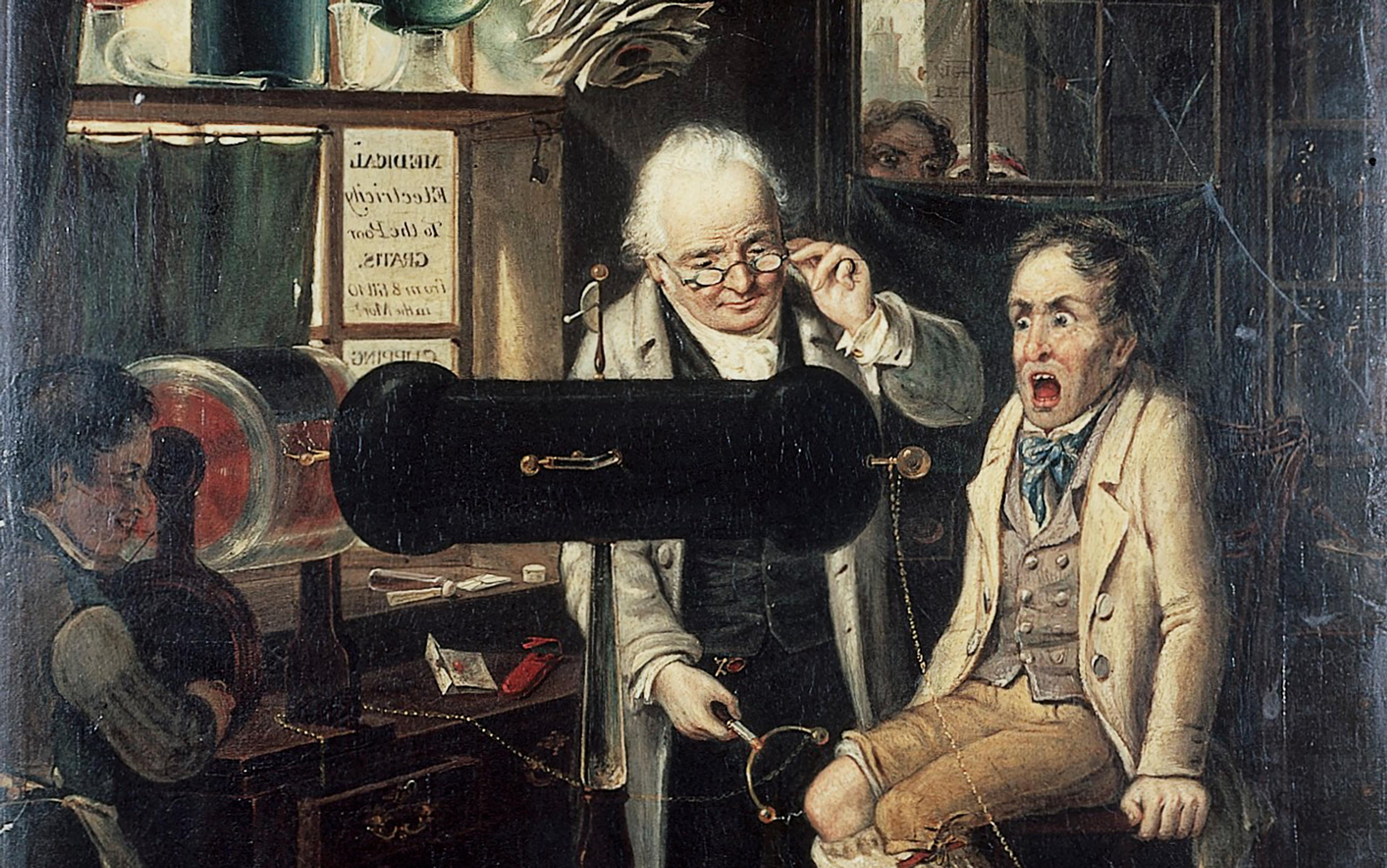To celebrate the Exposition Universelle held in Paris in 1900, a number of French artists were commissioned to produce a series of cigar box cards on the theme ‘En l’an 2000’. They came up with some fantastic imagery: in the future world they portrayed there was clearly going to be a great deal of aerial warfare and submarine sport, and a lot of electricity. The denizens of the year 2000 would put on their makeup with electricity, they would farm with electricity, and travel everywhere by electricity.
In one especially striking image, a group of schoolboys sit at their desks with electrodes strapped to their heads. In the corner of the classroom, their teacher feeds textbooks into a machine that minces them up, distils the information they contain and transmits it directly into the schoolboys’ brains. That century-old image of French schoolboys having their heads electrically pumped full of knowledge seems a good place to start thinking about a more recent manifestation of bodily electricity: the announcement by researchers a few months ago that electrical stimulation of the brain could turn us all into better thinkers.
In February 2016, scientists working at the Catholic University Medical School in Rome published experimental results showing that the memory and mental performance of lab mice could be significantly improved after short bursts of very low-intensity electric current were delivered to their brains through electrodes attached to their scalps. The scientists found that the electric stimulation led to increased levels of a protein called BDNF that plays an important role in neural development. Two years before, scientists at Northwestern University announced that using a technique called Transcranial Magnetic Stimulation to deliver electrical currents, they’d improved memory in their human experimental subjects. Both research teams highlighted how their methods might offer better treatment of diseases such as Alzheimer’s disease and other disorders involving memory loss, as well as improving memory in healthy people. The Italian study was sponsored by the Office of Naval Research and was hailed as offering ways to enhance the performance of military personnel in highly stressful situations, too.
It’s not only the mind that a dose of electricity can help. Some gyms now offer clients the option of electrical stimulation as they exercise. Imagine going through your usual routine, but dressed in a full body suit festooned with electrodes; as you exercise, the electrodes deliver a series of small electric shocks that further stimulate the muscles, providing an additional workout.
Technologies like these, that use electricity to enhance body and mind, are often presented as the cutting edge of science. But those French illustrations should remind us that using electricity to improve ourselves has been part of our technological imaginations for some time. What is it about electricity that makes it seem such a fertile resource for these sorts of transformations? And how has our changing understanding of our electrical selves been shaped and reshaped as we have turned electricity into a powerful tool for remodelling ourselves?
Let’s start with Sir Isaac Newton. In successive editions of his Opticks (first published in 1704), Newton was in the habit of adding what he called ‘queries’, or questions, that in fact tended to be rather more like magisterial statements of his views on contentious issues in science. ‘Is not Animal Motion perform’d by the Vibrations of this Medium,’ Newton ‘asked’ in one of these, ‘excited in the Brain by the power of the Will…?’ He meant the ether, but to many of his followers that meant electricity too. Experimenters playing with this mysterious new power knew that it did strange things to their bodies as well. It could make their hair stand on end and attract bits of feather or scraps of cloth to their fingertips. The natural philosopher Stephen Gray demonstrated how this strange power of attraction and repulsion could act at a distance by suspending a child in the air and passing the electricity from his generator through its body.
Enough electricity could make a human body jump and twitch. In 1746, Jean-Antoine Nollet used electricity to make a line of a 108 royal guardsmen jump into the air simultaneously. This trick amused Louis XV so much that he had Nollet repeat it in Paris with a line of 800 Carthusian monks. Demonstrations like these suggested there was something visceral about electricity that pulled and twisted muscles and nerves.
Electricity was about sex as well. In one popular demonstration, a young woman stood on a stool holding the chain from an electrical machine. As long as no one touched her all was fine, but when a gentleman was challenged to give her a kiss the sparks flew. Then there was medical entrepreneur James Graham’s Celestial Bed. In 1781, based at his Temple of Hymen on fashionable Pall Mall in London, Graham charged wealthy childless clients £50 a night to have sex in the electrified dome and forged a link between electricity, sex and fertility that would persist throughout the Victorian era.
The discovery of so called ‘animal electricity’ was announced to the world in 1791 by the Italian physician Luigi Galvani. For the previous decade Galvani had been experimenting with the effects of electricity on living tissue and had concluded that all animals – including humans – had their own innate electricity, secreted by the brain and distributed through the body by the nervous system. It was whilst trying (and largely failing) to disprove Galvani’s claims that his fellow Italian, Alessandro Volta, invented the instrument he called the pile – what is now called an electric battery. At about the same time, another physician, the Viennese doctor Franz Anton Mesmer, developed his theories about animal magnetism. Mesmer claimed that all bodies contained a magnetic fluid; by manipulating that fluid, he believed, he could cure mental and nervous diseases, as well as make his magnetised (or mesmerised) clients act like puppets, subservient to his own controlling mind.
The notion that people’s bodies contained mysterious electric and magnetic fluids that made them susceptible to others’ control was both fascinating and terrifying in the closing decades of the 18th century. These were the best of times, and the worst, as the revolution ignited in France and swept across Europe. Conspiracy theories about secret groups of powerful men pulling at the puppet strings of society for their own inscrutable purposes were rife. Galvanism (animal electricity) and mesmerism (animal magnetism) alike looked like the tools they might be using to destroy culture – or that was how they seemed to a hysterical Edmund Burke in his Reflections on the Revolution in France (1790), and to his friends at the Anti-Jacobin Review. Some of those Jacobin revolutionaries agreed. If electricity, rather than the soul, really was the power that governed bodies and minds, then it could be a very potent political weapon indeed. Electricity was heady and dangerous stuff. Its intimate relationship with our bodies and ourselves made it so.
In 1803, Giovanni Aldini (Galvani’s nephew) visited London to defend animal electricity against its detractors. At one performance he electrified a decapitated dog, with the Prince Regent in the audience. As the climax of his visit he carried out galvanic experiments at the Royal College of Surgeons on the body of a man named George Forster, just hanged for murder. It was a gruesome affair: ‘The jaw of the deceased criminal began to quiver, the adjoining muscles were horribly contorted, and one eye was actually opened.’ Aldini was lampooned in the anti-radical press as just another buffoon trying to con the public that electricity was life. But even amongst the relatively staid fellowship of the Royal Society, Aldini had plenty of supporters. He was sponsored by the Royal Humane Society who thought his experiments offered a way of bringing drowned sailors back to life.
Mary Shelley certainly knew about Aldini’s experiments when she wrote Frankenstein. Discussions about electricity, the soul and the possibilities of artificial life were common currency in the literary and political circles in which she and her husband moved. In 1818, the year Frankenstein was published, another electrical resurrection was attempted in Glasgow, this time on the body of a convicted murderer called Matthew Clydesdale. The experiments were carried out by doctor Andrew Ure, who waxed dramatically on how electricity turned the dead man’s body into an automaton: ‘Every muscle in his countenance was simultaneously thrown into fearful action: rage, horror, despair, anguish, and ghastly smiles, united their hideous expression in the murderer’s face.’ Seventeen years later, in his Philosophy of Manufactures, which extolled the virtues of the factory system, Ure celebrated the ways in which machines forced their human operators to act like automata. An exasperated Karl Marx called Ure ‘the Pindar of the automatic factory’.
Nervous diseases were usually treated by drawing sparks from the spine and administering electric shocks
If the body was really electric, it had all sorts of interesting implications. The Edinburgh publisher Robert Chambers in his scandalous and bestselling Vestiges of the Natural History of Creation, anonymously published in 1844, argued that all the evidence showed ‘the absolute identity of the brain with a galvanic battery’. He was not the only one to think so. The Welsh natural philosopher (and inventor of what we now call the fuel cell) William Robert Grove said the electric battery was ‘the nearest approach man has made to an experimental organism’. One of the most thoroughgoing Victorian attempts to turn humans into electrical machines was Alfred Smee’s Elements of Electro-biology (1849). Smee, a Tory and an Anglican, might have agreed with the liberal Chambers that the brain was a battery and that the nerves were ‘bio-telegraphs’, but that was the full extent of their agreement.
Smee thought that he could use his system of electrobiology to defend orthodox religion against radicals and unbelievers, since the electrical arrangements of the brain demonstrated the existence of God. We differed from animals, he claimed, because we had an extra bit of circuitry in our brains that allowed us to conceive of the divine. Smee went into considerable detail, showing how the different senses of sight, hearing, smell, taste and touch might be reproduced with the appropriate electrical apparatus. The sense of sight, for example, might be produced by photosensitive chemicals in the eye reacting to light and sending electrical messages to the brain. Not everyone appreciated his meticulous concern for detail. Reviewers had a great deal of fun at his expense, and his efforts to construct ‘a living, moving, feeling, thinking, moral, and religious man, by a combination of voltaic circuits’.
However, if Smee was right and the nerves really were full of electrical fluid, then a dose of electricity could cure nervous disorders. After he took up a position at Guy’s Hospital in London in 1836, the physician Golding Bird opened an ‘electrical room’ where he offered electrotherapy to suitably deserving patients (large hospitals like this were charitable institutions meant to provide medical care for the deserving poor – who also made good experimental fodder). Bird published exhaustive lists describing the sufferers’ ailments, the electrical treatment and the cure (or otherwise). Nervous diseases such as chorea, caused in one instance by ‘terror from confinement in a cellar’, were usually treated by drawing sparks from the spine and administering electric shocks. Other treatments included an electric bath.
Bird’s electrical treatments at Guy’s were entirely orthodox, designed to stimulate the nerves and muscles. There were plenty of less orthodox alternatives on the market though. Bird complained that his commercial rivals ‘blazon their electrical and galvanic nostrums as a panacea for every ill’. The number of ‘medical galvanists’ had increased, he thought, ‘in the shape of the persons employed at some of the railways to exhibit the electric telegraph’.
The electric telegraph is key to understanding the way Victorians thought about their bodies and electricity. Invented in 1837 by Charles Wheatstone, professor of experimental philosophy at King’s College London, and William Fothergill Cooke, the telegraph’s capacity for almost instantaneous communication revolutionised how Victorians understood their world. A fascinating two-way metaphor soon developed in which the rapidly expanding telegraph network got used as a tool for understanding the nervous system, whilst the nervous system was invoked to explain the operations of the telegraph. Nerves, as we’ve seen, were ‘bio-telegraphs’, while according to Andrew Wynter writing in the Quarterly Review in the 1850s, the London headquarters of the Electric Telegraph Company was like ‘the great brain – if we may so term it – of the nervous system of Britain’. The telegraph engineer George Wilson prophesied how the telegraph would, ‘like the great nerves of the human body, unite in living sympathy all the far-scattered children of men’. The nervous system circulated information and instructions through the body, just as the telegraph network circulated information and instructions through society: in both cases electricity was the medium of communication.
If the body and its nervous system was just like the telegraph network then its electrical characteristics could be measured and standardised in just the same way. So telegraph engineers and medical electricians drew graphs of the human body’s resistance to electricity. They wondered just what sort of electrical apparatus the body was like. Was it like something relatively simple, such as a piece of the transatlantic telegraph cable (probably one of the best understood pieces of equipment in the late Victorian electrical world)? Or something more complicated, like a telephone receiver? In a world where electric power was beginning to be used in the home (with consequent dangers), and, after 1890, in a world where people were deliberately killed with electricity, they wondered and experimented on the physiology of death by electric shock. Practitioners of electrical medicine quarrelled over whether electricity should be delivered in standard doses or tailored to individual patients’ bodies.
Customers were also offered massages, during which electrical currents from the masseur’s hands would flow through their bodies
At London’s Institute of Medical Electricity on fashionable Regent Street, entrepreneurial telegraph engineers joined medical men to offer the latest regimes of electro-medical treatment to the paying public – it was a joint stock company after all. Customers were assured of ‘high-class instruments, skilled attendants, accurate measurements and careful records’. This was one of the places where the link between electricity, exercise and health that is still with us today was first forged.
Patients at the institute could take their turn on the electro-gymnastic apparatus and exercise whilst being given electrical treatment. The place also featured an ‘electrified room system’, where a powerful induction coil connected between floor and ceiling set up a rapidly alternating field, which induced currents in the bodies of anyone inside it. Customers were also offered massages, during which electrical currents from the masseur’s hands would flow through their bodies. Those without the wherewithal to pay five shillings for a half-hour session could take the short walk to Oxford Street instead, and in 1891, buy one of C B Harness’s electropathic belts or corsets at the Medical Battery Company.
‘Electricity is Life’ was the Harness slogan. Yet it was a way to reshape the body’s future too. In his novel The Coming Race (1871) Edward Bulwer-Lytton fantasised about a subterranean race of beings called the Vril-ya, who controlled their world through their ability to manipulate electricity with their minds and bodies. If that seems too fantastic, the chemist, spiritualist and future president of the Royal Society, William Crookes, speculated in 1892 that there might be electrical organs inside the human brain that could allow thoughts to be transmitted from mind to mind through the electromagnetic ether.
Speculative authors like E E Kellett in The Lady Automaton (1901) imagined the construction of crying, talking, sleeping, walking electrical dolls that were indistinguishable from the real thing. The physicist Oliver Lodge wondered if the components of Guglielmo Marconi’s newly-invented radio apparatus offered a clue to how bodies were made. Was the nervous system a coherer, he wondered? The medical electrician Julius Althaus thought that ‘careful and appropriate use of the constant galvanic current’ offered a way of extending life. Electricity offered a language and a technology that could explain the shape of bodies to come.
Electricity remains deeply embedded in the way we now think about our bodies ourselves; we invoke electricity between people when we discuss sexual attraction, if we’re riveted by a theatre performance, we’re electrified, and when something shocks us into new states of feeling we say ‘it was electric’. We still think of ourselves as electric bodies. From Stephen Gray’s charity boys demonstrating conduction onwards, we have made ourselves electrical.
Just as the Victorians saw themselves as possessing bodies that mirrored the technological novelty of telegraphy, we now model ourselves on electronics. Our brains may be computers running algorithms that tell us what to do, rather than telegraph offices or telephone exchanges, but we retain the Victorian habit of modelling ourselves on technology. We mirror ourselves in our technologies, and as our contemporary culture carries on the trend of being ever more immersed in technologies that we see as being like us, that becomes an easier and more compelling way of being ourselves.
If we can use electricity to drive ourselves into better shape, it can be used to drive us into the ground as well
When exercise entrepreneurs try and sell us body suits that will shock us into health they’re repeating history, and the notion seems seductive because thinking this way about electricity and our bodies is culturally familiar for us. That electricity might boost brain power, or be used to cure neural disorders, seems right to us in the same way that it did to the Victorians. The use of deep brain stimulation to treat diseases such as Parkinson’s would seem very familiar to them, for example. Like the Victorians, we’re still using electricity and its technologies to project our bodies into the future, so that when we futurise our electric bodies, we’re reenacting our past.
That means that electric bodies can be frightening as well as seductive, though. They had Frankenstein’s monster; we have AI running amok. When Yuval Noah Harari or Stephen Hawking tell us to worry about a world dominated by electronic life, we take their claims seriously precisely because theirs is a dark fantasy already firmly built into our cultural circuitry. This is the necessary flipside of thinking that we can electrically engineer ourselves to be better. If we can use electricity to drive ourselves into better shape, it can be used to drive us into the ground as well. Currents to the brain can torture as well as cure. If confusing our bodies with our latest technologies is a pervasive feature of modern life (and it is), the conflation promises pain as well as pleasure. Electric dreams can also be nightmares.






